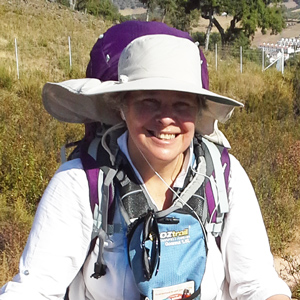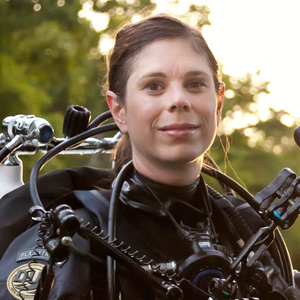40 Years Later, I Set Out to Walk the Camino de Santiago: Nancy Liddle’s Quest
This is a quest case study. (Read others or nominate yourself.)
Nancy wasn’t sure she could complete an 850-kilometer walk on the Camino de Santiago in Spain. But she did, and discovered something about age in the process. Here’s how it happened.
Introduce yourself and your quest.
My name is Nancy and last year I fulfilled my 40-year-old dream to walk the Camino de Santiago in Spain. Being 56, relatively unfit, single, and never having walked more than 10 kilometers in my life was intimidating, but I did it.

Was there a reason you delayed your quest for so long?
A few reasons. For one, something always got in the way—going to university, getting married, needing to work—I did everything except realize my dream it seems.
But more than that, I put off the walk because I lacked confidence. I doubted myself. I felt too young, too much of a girl, too afraid to venture out on my own, too scared of the actual logistics. I lacked self-belief.
Despite all that, the urge to walk the Camino never left me. It nagged me until I finally did it.
What inspired you to want to walk the Camino?
It started by being interested in walking. When I was younger, I wanted to explore the immensely satisfying feeling of being consumed by an activity. Long walks absolutely do that.
Then at college, I read Robyn Davidson’s Tracks, and her story of trekking off by herself for a vast difference was inspiring. The engrossing use of body and mind and soul in walking was something I could do, too (and it was free!).
Finally, I read Shirley MacLaine’s book on her Camino (that’s lingo – walkers simply call the walk their Camino) and the spirituality of her travels impressed me.
Did anything surprise you on the Camino?
I was one of the youngest pilgrims out there! In fact, the oldest person I talked to was 94. And all of us – walkers, cyclists, bikers – were traveling 20 or so kilometers a day.
The people on the Camino really showed me that our obsession with youth culture is a hoax. As we age, we don’t need to consider ourselves weaker, fragile, or even invisible.

How did walking the Camino change how you felt about your age?
I think it’s safe to say that our societal focus on youth culture encourages anyone over 40 to think of getting older as a disease. In particular, there’s a paranoia generated in women that we should worry about our looks instead of fulfilling our ambitions and dreams.
Part of that anti-aging campaign implies that getting older is equated to becoming less physically able. For example, my mother never exercised. In fact, I doubt she would have conceived she could walk the Camino. She died at the age I am now.
Before I left last year at the age of 56, I thought my casual practice of walking 8 kilometers every other day was “heroic.” My lower back has severe arthritis and I worried about being able to carry the rucksack along each day. I sincerely thought I may not be able to complete the Camino because I was “a bit old.”
But realizing I was one of the youngest pilgrims out there changed that.
What was impressed upon me the most was that as we age, like trees, we do not necessarily get feebler – unless we let it happen. Our bodies are actually designed to be work-horses. We age like old wines, strong and smooth.
I don’t want to end up in a nursing home at the “tender age” of 70—I want to be out roaming the wilds, using my mind and body until I drop.
How much did your Camino cost? How did you pay for it?
The plane ticket from Australia to Spain was about $3,000. Since I snore, I chose to stay in hotels every night for the 70 day period costing between $30-$50 a night—about $2,100 in total. Many pilgrims (that’s what Camino walkers are called) save a lot of money by staying in free or low-cost dorms.
I paid for everything by dipping into some of my retirement savings. I’d already taken money out to renovate my house, and I figured I’d use what was left to renovate my mind.
Tell us about a memorable encounter while on the Camino.
It seemed that no matter how often I got lost, a local would magically appear, decipher my attempt at Spanish, and help me find my way. One such angel appeared in Ourense. I couldn’t find the yellow flechas that point pilgrims out of modern cities and keep them on the ancient Camino pathways. Everywhere was traffic, concrete, and cars, and I was getting frustrated.
A local man I asked for help actually walked me to the Roman bridge. On the way, he gave me the historical background of the surrounding architecture (all in Spanish, and I didn’t understand most of it). Then, he kissed my hand like a chivalrous knight and sent me on my way.
You can’t imagine the uplift I got from that, given that I am a grey haired senior woman walking on her own! It was a special moment.

How did you overcome a low point on your quest?
On day 27 of my walk, an overly well-meaning Frenchman offered to wait for me every few kilometers thinking I was in desperate need of assistance, which may or may not have been due to our language barrier. I hadn’t asked for help, nor thought I seemed in dire need of it, and politely refused multiple times.
Lo and behold, he kept waiting for me, even though I was at least half an hour slower than he and his walking partner work.
“I’ll see you at the somethingsomething,” he said to me in broken English. Was it the top of the hill or the bottom? I couldn’t tell. Which became an issue when I hadn’t seen him in two hours.
A cyclist came riding by, asking if I was “the Australian?” He had just spoken to the Frenchman, who had been waiting for me for an hour—at a spot I’d already passed! You could have knocked me down with a feather—how had I missed him? To make matters weirder, it wasn’t just him waiting. He’d gotten a few more pilgrims plus a set of cyclists to wait with him.
It was then my turn to be the wait-er. As soon as I saw the Frenchman come up the path, I waved my sticks at him, smiling. But his face was very dark, and he immediately began berating me for not seeing him. He told me he’d even made extra flechas for me on the path in case I got lost. This ended with him saying he wasn’t happy and would never wait for anyone again.
I was gobsmacked. Surely it was clear that if I’d seen him up there I would have greeted him and thanked him as I’d already done so before? It reminded me of a really bad day during marriage, full of unspoken gripes and misunderstandings.
I let him be on his way, then called for a taxi and went to the next city over, making sure to put enough distance between us that I wouldn’t see him on the Camino again.
Had this series of events happened back in Australia, I’d have probably been in tears by the end of it. But time on the Camino had changed me. Instead I recognized I hadn’t done anything wrong, and frankly, I felt grand. His problem was not my problem.

Do you have any advice for someone like you who is thinking about taking a quest?
My actionable advice really comes down to “just do it” – as nervous as you feel about it, commit to it. And if you feel like retching after you make the choice, you certainly can.
What’s next?
I have a series of varied walks I do around my town – from 8ks to 15ks. I’d love to return to Spain and do another Camino at some point.
Keep up to date on Nancy’s quest at her site, Walk Sit or on Twitter at @walkingsitting
###







